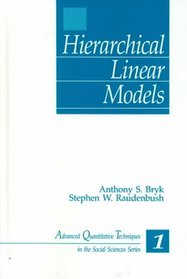Search -
Hierarchical Linear Models: Applications and Data Analysis Methods (Advanced Quantitative Techniques in the Social Sciences)
Hierarchical Linear Models Applications and Data Analysis Methods - Advanced Quantitative Techniques in the Social Sciences
Author:
"This monograph offers a careful introduction to models designed to deal with interactions between individual and contextual effects . . . . This book is an important contribution to the analysis of hierarchical data. It presents the material in sufficient depth without ignoring the demands of nonspecialists." --American Journal of Sociology ... more »
Author:
"This monograph offers a careful introduction to models designed to deal with interactions between individual and contextual effects . . . . This book is an important contribution to the analysis of hierarchical data. It presents the material in sufficient depth without ignoring the demands of nonspecialists." --American Journal of Sociology ... more »
ISBN-13: 9780803946279
ISBN-10: 0803946279
Publication Date: 3/3/1992
Pages: 265
Rating: ?
ISBN-10: 0803946279
Publication Date: 3/3/1992
Pages: 265
Rating: ?
0 stars, based on 0 rating
Publisher: Sage Publications, Inc
Book Type: Hardcover
Members Wishing: 0
Reviews: Amazon | Write a Review
Book Type: Hardcover
Members Wishing: 0
Reviews: Amazon | Write a Review
Genres:
- Nonfiction >> Social Sciences >> General
- Nonfiction >> Social Sciences >> Research
- Nonfiction >> Social Sciences >> Statistics
- Science & Math >> General
- Science & Math >> Mathematics >> Applied >> Linear Programming
- Science & Math >> Mathematics >> Applied >> Probability & Statistics
- Engineering & Transportation >> Professional Science >> Mathematics >> Applied >> Linear Programming
- Engineering & Transportation >> Professional Science >> Mathematics >> Applied >> Statistics




